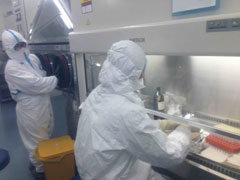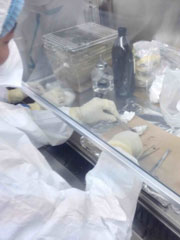- Home
- Technical Cooperation Projects
- Index of Countries
- Asia
- Viet Nam
- The Project for capacity development for laboratory network in Vietnam of biosafety and examination of highly hazardous infectious pathogen
- Project News
- Training course on laboratory diagnosis of Rickettsiosis in NIHE
Project News
2015-01-23
Training course on laboratory diagnosis of Rickettsiosis in NIHE
Rickettsiosis displays 3 main clinical symptoms such as fever, rash and systemic malaise after transmitted by vectors such as infected trombiculid mites in scrub typhus. Rickettsial infections are suspected to account for main part of unknown fever diseases in the Southeast Asia including Vietnam by judging from the distribution of vectors mediating these infectious diseases. Only limited typical cases can be counted in the current situation of Vietnam since diagnosis of Rickettsiosis has been performed solely depending on clinical symptoms of patients with fever, rash and systemic malaise without evidence based on laboratory testing. Laboratory diagnosis of Rickettsiosis has not yet been established due to lack of standard protocols employed in Vietnam. Consequently, information on the occurrence and numbers of patients has been so far indefinite since most of cases representing atypical symptoms have been interpreted as the numbers of patients with fever of unknown cause. Although antimicrobiotics such as tetracyclin series have excellent therapeutic effect on Rickettsiosis, delay of treatment often results in sever condition of patients with sometime death. Therefore the introduction of good microbiological technique on laboratory diagnosis might make it possible to timely treat patients and prevent such sever cases of patients from often taking place in Vietnam.
To strengthen the capacity of laboratory diagnosis on Rickettsia, training course was organized in Laboratory of Rickettsiosis, Virology Department, National Institute of Hygiene and Epidemiology (NIHE) from January 13 to 21, 2015 under the instruction of a short-term expert, Dr. Kozue HOTTA (Laboratory of Veterinary Public Health, Department of Veterinary Medical Science, Graduate School of Agricultural and Life Science, the University of Tokyo, Japan). The training course included lectures and practice covering several aspects such as culture isolation method as basic laboratory diagnosis of Rickettsiosis, serological and PCR diagnosis methods. Participants attending this training course were Ms. Nguyen Le Khanh Hang and 5 researches (Laboratory of Rickettsia, Virology Department, NIHE). The training course was organized with special focus on isolating pathogens from Vietnamese patients as standard strains in order to establish laboratory network of Rickettsiosis in Vietnam. In the laboratory for animal experiment of BSL-3 in NIHE, Dr. HOTTA supervised trainees how to inoculate mice with samples derived from patients showing typical symptoms of scrub typhus, one of Rickettsiosis, how to safely sacrifice them in BSC and how to take samples from them for subsequent laboratory examination and storage of pathogens. Trainees learned a series of practical procedures how to inoculate and get samples for isolation and storage of relevant pathogens. The training course provided NIHE researchers to have practical experience in procedure of isolation and storage of pathogens. Training course represents techniques indispensable for NIHE as the top referral institute in order to establish laboratory network of Rickettsiosis in Vietnam and standardize the SOP in near future. Establishment of the standard SOP might shed light on these so-far indefinite Rickettsial infections in Vietnam with reduction in the numbers of patient's death.
 Transfer of mouse cages from animal space to BSC and autopsy and sampling from infected mice inside BSC in animal laboratory of BSL-3, NIHE.
Transfer of mouse cages from animal space to BSC and autopsy and sampling from infected mice inside BSC in animal laboratory of BSL-3, NIHE.
 Transfer of mouse cages from animal space to BSC and autopsy and sampling from infected mice inside BSC in animal laboratory of BSL-3, NIHE.
Transfer of mouse cages from animal space to BSC and autopsy and sampling from infected mice inside BSC in animal laboratory of BSL-3, NIHE.
- About JICA
- News & Features
- Countries & Regions
- Our Work
- Thematic Issues
- Types of Assistance
- Partnerships with Other Development Partners
- Climate Change / Environmental and Social Considerations
- Evaluations
- Compliance and Anti-corruption
- Science and Technology Cooperation on Global Issues
- Research
- JICA Development Studies Program / JICA Chair
- Support for the Acceptance of Foreign HRs / Multicultural and Inclusive Community
- Publications
- Investor Relations
